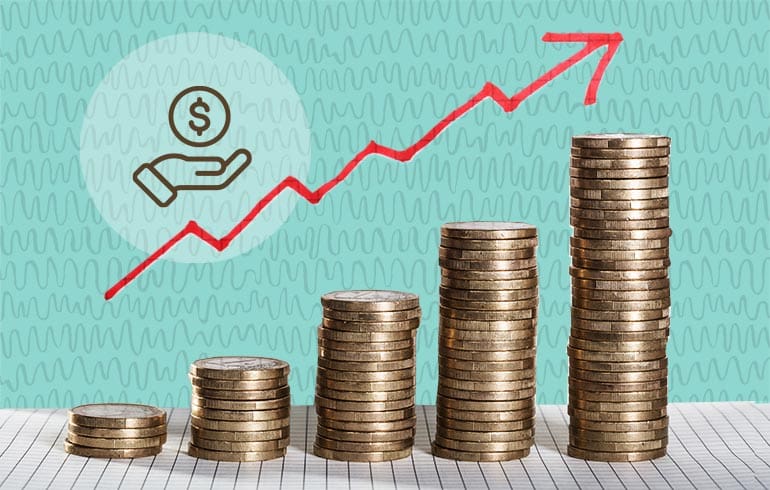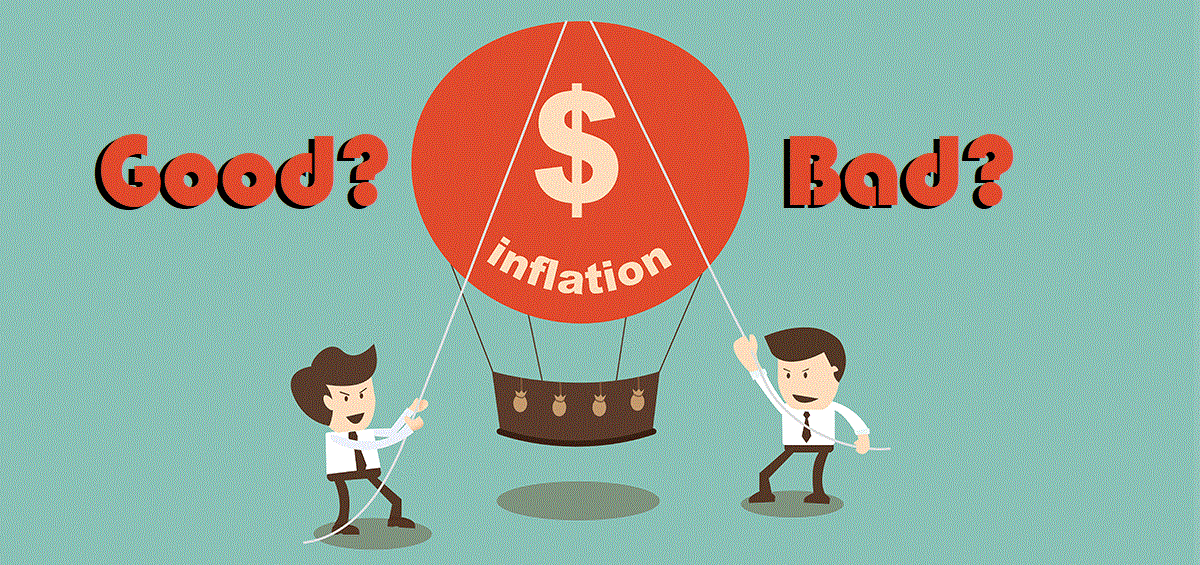
⭐️ គន្លឹះសំខាន់
– អតិផរណាគឺជាស្ថានភាពនៅពេលដែលតម្លៃទំនិញ និងសេវាកម្មឡើងថ្លៃ ដែលនាំឱ្យអំណាចទិញនៃរូបិយប័ណ្ណធ្លាក់ចុះ។
– មានកត្តាជាច្រើនដែលអាចរួមចំណែកដល់អតិផរណា ហើយកត្តាទាំងនោះមានដូចជា អតិផរណាដោយតម្រូវការ (Demand-pull Inflation), អតិផរណាដោយថ្លៃដើម (Cost-Push Inflation), Built-in Inflation, គោលនយោបាយរូបិយវត្ថុ និងគោលនយោបាយសារពើពន្ធ។
– មានការចាត់ថ្នាក់អតិផរណាចំនួន 5 ដោយផ្អែកលើអត្រាដែលតម្លៃកើនឡើង។
– ការវាស់ស្ទង់អតិផរណាពាក់ព័ន្ធនឹងការតាមដាន និងកំណត់បរិមាណនៃការផ្លាស់ប្តូរនៅក្នុងកម្រិតតម្លៃរួមនៃទំនិញ និងសេវាកម្មនៅក្នុងសេដ្ឋកិច្ចតាមពេលវេលាជាក់លាក់ណាមួយ។
– ផលវិបាកនៃអតិផរណាខ្ពស់ អាចបំផ្លាញអំណាចទិញនៃរូបិយប័ណ្ណ ដែលជាហេតុធ្វើឱ្យមានផលវិបាកសម្រាប់អ្នកប្រើប្រាស់ក្នុងការរក្សាកម្រិតជីវភាពរបស់ពួកគេ។
– ឥទ្ធិពលនៃអតិផរណាលើសេដ្ឋកិច្ចគឺមានភាពខុសប្លែកគ្នា និងប្រែប្រួលទៅតាមអត្រា និងស្ថិរភាពរបស់វា។
⭐️ ឈ្វេងយល់ពីអតិផរណា
អតិផរណាគឺជាស្ថានភាពនៅពេលដែលតម្លៃទំនិញ និងសេវាកម្មឡើងថ្លៃ ដែលនាំឱ្យអំណាចទិញនៃរូបិយប័ណ្ណធ្លាក់ចុះ។ ឬអាចនិយាយបានថា អតិផរណាគឺជាការកើនឡើងនៃថ្លៃជីវភាពរស់នៅក្នុងកំឡុងពេលណាមួយ ដែលជាហេតុធ្វើការឱ្យមានការទិញទំនិញ និងសេវាកម្មបានតិចជាងមុន។

(ប្រភព៖ Investopedia)
⭐️ កត្តាដែលធ្វើឱ្យមានអតិផរណា
មានកត្តាជាច្រើនដែលអាចរួមចំណែកដល់អតិផរណា ហើយកត្តាទាំងនោះមានដូចជា៖
– អតិផរណាដោយតម្រូវការ (Demand-pull Inflation)៖ គឺជាអតិផរណាដែលកើតឡើងនៅពេលដែលមានតម្រូវការទំនិញ និងសេវាកម្មច្រើនជាងការផ្គត់ផ្គង់។ ជាងនេះទៅទៀត នៅពេលដែលប្រជាជនមានលុយច្រើន ហើយដណ្តើមគ្នាទិញទំនិញដែលកំពុងតែមានបរិមាណតិចនៅក្នុងទីផ្សារ ពេលនោះហើយដែលតម្លៃទំនិញមានទំនោរកើនឡើង ឬទំនិញឡើងថ្លៃ។
– អតិផរណាដោយថ្លៃដើម (Cost-Push Inflation)៖ គឺជាអតិផរណាដែលកើតឡើងនៅពេលដែលថ្លៃដើមផលិតកម្មសម្រាប់ទំនិញ និងសេវាកម្មកើនឡើង ដែលជារឿយៗវាបណ្តាលមកពីកត្តាមួយចំនួនដូចជា ការកើនឡើងប្រាក់ឈ្នួល ឬថ្លៃដើមនៃវត្ថុធាតុដើមសម្រាប់ផលិត។ ដូចនេះ នៅពេលដែលថ្លៃដើមនៃការផលិតឡើងថ្លៃ ពេលនោះហើយដែលទំនិញដាក់លក់ក្នុងទីផ្សារក៏មានការឡើងថ្លៃផងដែរ។
– Built-in Inflation៖ Built-in Inflation ឬជួនកាលគេហៅថាអតិផរណាតម្លៃប្រាក់ឈ្នួល គឺជាអតិផរណាដែលកើតឡើងនៅពេលដែលកម្មករទាមទារប្រាក់ឈ្នួលខ្ពស់ ហើយម្ចាស់អាជីវកម្មក៏ដំឡើងតម្លៃទំនិញរបស់ពួកគេដើម្បីផ្គត់ផ្គង់ការចំណាយប្រាក់ឈ្នួលដែលឡើងថ្លៃទាំងនោះ។ ការទាមទារឡើងប្រាក់ឈ្នួល និងការដំឡើងថ្លៃទំនិញទាំងអស់នេះហើយ ដែលបង្កើតបានជាវដ្តនៃការកើនឡើងនៃប្រាក់ឈ្នួល និងតម្លៃទំនិញ។
– គោលនយោបាយរូបិយវត្ថុ៖ ធនាគារកណ្តាលដូចជា Federal Reserve នៅសហរដ្ឋអាមេរិក អាចមានឥទ្ធិពលលើអតិផរណាតាមរយៈការផ្គត់ផ្គង់ប្រាក់នៅក្នុងសេដ្ឋកិច្ច។ ប្រសិនបើធនាគារកណ្តាលបង្កើនការផ្គត់ផ្គង់ប្រាក់យ៉ាងឆាប់រហ័ស នោះវាអាចនាំឱ្យមានអត្រាអតិផរណាខ្ពស់ ដោយសន្មតថាកត្តាផ្សេងទៀតនៅក្នុងសេដ្ឋកិច្ចមានស្ថិរភាព។
– គោលនយោបាយសារពើពន្ធ៖ ការចំណាយរបស់រដ្ឋាភិបាល និងពន្ធដារក៏អាចប៉ះពាល់ដល់អតិផរណាបានផងដែរ។ ជាឧទាហរណ៍ ការចំណាយលើឱនភាព (នៅពេលដែលរដ្ឋាភិបាលចំណាយលើសពីការប្រមូលពន្ធ) អាចរួមចំណែកដល់អតិផរណា ប្រសិនបើវាមិនមានភាពត្រូវគ្នានឹងការកើនឡើងនៃសមត្ថភាពផលិតភាពរបស់សេដ្ឋកិច្ច។
⭐️ ចំណាត់ថ្នាក់អតិផរណា
មានការចាត់ថ្នាក់អតិផរណាចំនួន 5 ដោយផ្អែកលើអត្រាដែលតម្លៃកើនឡើង:
1. Creeping Inflation (1-4%): Creeping Inflation គឺជាអតិផរណាដែលមានអត្រាកើនឡើងតិចតួច ដែលជាធម្មតាកើនឡើងនៅក្នុងចន្លោះពី 1% ទៅ 4% ក្នុងមួយឆ្នាំ។ ជារឿយៗវាត្រូវបានគេចាត់ទុកថាជាកម្រិតអតិផរណាធម្មតា និងអាចគ្រប់គ្រងបាន។ ធនាគារកណ្តាលក្នុងប្រទេសជាច្រើនមានបំណងរក្សាអតិផរណាក្នុងរង្វង់នេះ ដើម្បីលើកកម្ពស់ស្ថិរភាពសេដ្ឋកិច្ច។
2. Walking Inflation (2-10%): Walking Inflation គឺជាអតិផរណាដែលមានអត្រាកើនឡើងក្នុងតម្លៃមធ្យម ដែលជាធម្មតាកើនឡើងនៅក្នុងចន្លោះពី 2% ទៅ 10% ជារៀងរាល់ឆ្នាំ។ អតិផរណាប្រភេទនេះអាចបំផ្លាញអំណាចទិញបានលឿនជាងអតិផរណា Creeping Inflation។ ដូចនេះ ធនាគារកណ្តាល និងអ្នកបង្កើតគោលនយោបាយតែងតែចាត់វិធានការដើម្បីការពារអតិផរណាប្រភេទនេះពីការឈានទៅរកកម្រិតខ្ពស់នៃជួរនេះ។
3. Running Inflation (10-20%): Running Inflation គឺជាអតិផរណាដែលមានអត្រាកើនឡើងយ៉ាងខ្លាំង ដែលជាធម្មតាកើនឡើងនៅក្នុងចន្លោះពី 10% ទៅ 20% ក្នុងមួយឆ្នាំ។ កម្រិតនៃអតិផរណានេះអាចប៉ះពាល់ដល់សេដ្ឋកិច្ចយ៉ាងខ្លាំងដូចជា កាត់បន្ថយការសន្សំ និងធ្វើឱ្យអាជីវកម្ម និងបុគ្គលមានការលំបាកក្នុងការរៀបចំផែនការសម្រាប់អនាគត។ ដើម្បីគ្រប់គ្រងអតិផរណាប្រភេទនេះបាន លុះត្រាតែរដ្ឋាភិបាលមានគោលនយោបាយរូបិយវត្ថុ និងសារពើពន្ធដ៏ខ្លាំងក្លាក្នុងការគ្រប់គ្រង។
4. Galloping Inflation (20-1000%): អតិផរណា Galloping នេះតំណាងឱ្យអត្រាអតិផរណាខ្ពស់ខ្លាំងដែលមានអត្រាចាប់ពី 20% ទៅ 1000% ជារៀងរាល់ឆ្នាំ។ នៅក្នុងកម្រិតនេះ តម្លៃទំនិញ និងសេវាកម្មអាចកើនឡើងទ្វេដង ឬកើនឡើងកាន់តែលឿនក្នុងរយៈពេលខ្លី។ អតិផរណា Galloping នេះ ជារឿយៗតែងតែធ្វើឱ្យមានវិបត្តិសេដ្ឋកិច្ច ហើយអាចនាំឱ្យមានអស្ថិរភាពសេដ្ឋកិច្ច និងសង្គមធ្ងន់ធ្ងរ។ ដើម្បីទប់ទល់នឹងអតិផរណាប្រភេទនេះបាន លុះត្រាតែមានវិធានការបន្ទាន់ ដើម្បីរក្សាស្ថិរភាពសេដ្ឋកិច្ច។
5. Hyperinflation (>1000%): Hyperinflation គឺជាទម្រង់អតិផរណាខ្ពស់ខ្លាំងបំផុត ដែលអត្រារបស់វាកើនឡើងក្នុងអត្រាលើសពី 1000% ក្នុងមួយឆ្នាំ។ អតិផរណាប្រភេទនេះអាចនាំឱ្យតម្លៃរូបិយប័ណ្ណ និងប្រព័ន្ធសេដ្ឋកិច្ចរបស់ប្រទេសមួយធ្លាក់ចុះខ្លាំង។ ជារឿយៗ អតិផរណាប្រភេទនេះបណ្តាលមកពីកត្តាមួយចំនួនដូចជា ការបោះពុម្ពលុយច្រើនពេក ការបាត់បង់ទំនុកចិត្តលើរូបិយប័ណ្ណ និងអស្ថិរភាពនយោបាយក្នុងស្រុក។ វាតម្រូវឱ្យមានវិធានការជាបន្ទាន់ដើម្បីស្ដារស្ថិរភាពសេដ្ឋកិច្ចជាតិឡើងវិញ។
ការចាត់ថ្នាក់អតិផរណាទាំងនេះត្រូវបានប្រើដើម្បីពិពណ៌នាអំពីភាពធ្ងន់ធ្ងរនៃអតិផរណាដោយផ្អែកលើភាគរយនៃការកើនឡើងតម្លៃក្នុងរយៈពេលជាក់លាក់ណាមួយ។ គោលដៅនៃគោលនយោបាយរូបិយវត្ថុ និងសារពើពន្ធគឺធ្វើយ៉ាងណាដើម្បីរក្សាកម្រិតអតិផរណានៅក្នុងកម្រិតដែលអាចគ្រប់គ្រងបាន ដែលជាធម្មតាគឺគេផ្តោតសំខាន់ទៅលើកម្រិតអតិផរណា Creeping ឬអតិផរណា Walking ដើម្បីលើកកម្ពស់ស្ថិរភាពសេដ្ឋកិច្ច និងការពារអំណាចទិញនៃរូបិយប័ណ្ណរបស់ប្រទេសមួយ។

⭐️ ការវាស់ស្ទង់អតិផរណា
ការវាស់ស្ទង់អតិផរណាពាក់ព័ន្ធនឹងការតាមដាន និងកំណត់បរិមាណនៃការផ្លាស់ប្តូរនៅក្នុងកម្រិតតម្លៃរួមនៃទំនិញ និងសេវាកម្មនៅក្នុងសេដ្ឋកិច្ចតាមពេលវេលាជាក់លាក់ណាមួយ។ វិធីសាស្រ្ត និងសន្ទស្សន៍ផ្សេងៗត្រូវបានប្រើសម្រាប់ការវាស់ស្ទង់អតិផរណានេះ។ នេះជាសេចក្តីសង្ខេបនៃវិធីសាស្ត្រទូទៅសម្រាប់វាស់អតិផរណា៖
1. សន្ទស្សន៍ថ្លៃអ្នកប្រើប្រាស់ (Consumer Price Index-CPI)៖ សន្ទស្សន៍ថ្លៃអ្នកប្រើប្រាស់ គឺជារង្វាស់អតិផរណាដែលត្រូវបានប្រើប្រាស់យ៉ាងទូលំទូលាយក្នុងការវាស់ស្ទង់កម្រិតអតិផរណា។ វាគណនាពីការប្រែប្រួលជាមធ្យមតាមពេលវេលានៃតម្លៃដែលបានបង់ដោយអ្នកប្រើប្រាស់សម្រាប់កញ្ចប់ទំនិញ និងសេវាកម្មដូចជាអាហារ សម្លៀកបំពាក់ លំនៅឋាន និងការដឹកជញ្ជូនជាដើម។ រដ្ឋាភិបាល និងធនាគារកណ្តាលតែងតែប្រើប្រាស់ CPI ដើម្បីតាមដាន និងកំណត់គោលដៅអតិផរណា។ CPI ត្រូវបានបង្ហាញជាភាគរយនៃការផ្លាស់ប្តូរពីឆ្នាំមូលដ្ឋាន (Base year)។
2. សន្ទស្សន៍តម្លៃអ្នកផលិត (PPI)៖ PPI វាស់វែងការផ្លាស់ប្តូរជាមធ្យមនៃថ្លៃលក់ដែលទទួលបានដោយអ្នកផលិតក្នុងស្រុកសម្រាប់ទំនិញ និងសេវាកម្មរបស់ពួកគេក្នុងរយៈពេលជាក់លាក់ណាមួយ។ វាអាចផ្តល់នូវការយល់ដឹងអំពីសម្ពាធអតិផរណាបន្ថែមទៀតពីខ្សែចង្វាក់ផលិតកម្ម។ ការកើនឡើងនៃតម្លៃផលិតកម្មអាចនាំឱ្យតម្លៃទំនិញប្រើប្រាស់កើនឡើងកាន់ខ្ពស់។
3. GDP Deflator: GDP Deflator គឺជារង្វាស់អតិផរណាដែលឆ្លុះបញ្ចាំងពីការផ្លាស់ប្តូរនៃតម្លៃទំនិញ និងសេវាកម្មទាំងអស់ដែលរួមបញ្ចូលក្នុងការគណនាតម្លៃផលិតផលក្នុងស្រុកសរុប (GDP) របស់ប្រទេសមួយ។ វាត្រូវបានប្រើដើម្បីកែសម្រួលផលិតផលក្នុងស្រុកសរុបមាននាម (Nominal GDP) ដើម្បីទទួលបានផលិតផលក្នុងស្រុកសរុបពិត (Real GDP) ដែលវាស់វែងលើអត្រាអតិផរណា។
4. សន្ទស្សន៍ថ្លៃចំណាយលើការប្រើប្រាស់ផ្ទាល់ខ្លួន (PCEPI)៖ សន្ទស្សន៍នេះប្រហាក់ប្រហែលនឹង CPI ដែរ ប៉ុន្តែផ្អែកលើការចំណាយលើការប្រើប្រាស់ផ្ទាល់ខ្លួនវិញ ដែលជាប្រភេទទំនិញ។ PCEPI ត្រូវបានត្រួតពិនិត្យយ៉ាងដិតដល់ដោយ Federal Reserve របស់សហរដ្ឋអាមេរិក នៅពេលដែលមានការកំណត់គោលនយោបាយរូបិយវត្ថុ។
ការវាស់ស្ទង់អតិផរណាឱ្យបានត្រឹមត្រូវគឺចាំបាច់ណាស់សម្រាប់អ្នកធ្វើគោលនយោបាយ អាជីវកម្ម និងបុគ្គលដើម្បីធ្វើការសម្រេចចិត្តផ្នែកសេដ្ឋកិច្ចសម្រាប់ពេលអនាគត។ ធនាគារកណ្តាលតែងតែប្រើប្រាស់ទិន្នន័យអតិផរណាដើម្បីកំណត់អត្រាការប្រាក់ និងអនុវត្តគោលនយោបាយរូបិយវត្ថុដើម្បីសម្រេចបាននូវគោលដៅអតិផរណារបស់ពួកគេ និងរក្សាស្ថិរភាពសេដ្ឋកិច្ច។ អតិផរណាខ្ពស់ អាចបំផ្លាញអំណាចទិញ និងរំខានដល់ការធ្វើផែនការហិរញ្ញវត្ថុ ក៏ដូចជាអាចប៉ះពាល់ដល់សុខភាពសេដ្ឋកិច្ចទាំងមូលបានផងដែរ។
⭐️ ផលវិបាកនៃអតិផរណាខ្ពស់
អតិផរណាខ្ពស់អាចមានផលវិបាកសំខាន់ៗចំនួនប្រាំ ដែលក្នុងនោះរួមមាន៖ ទីមួយ វាបំផ្លាញអំណាចទិញនៃរូបិយប័ណ្ណ ដែលជាហេតុធ្វើឱ្យមានផលវិបាកសម្រាប់អ្នកប្រើប្រាស់ក្នុងការរក្សាកម្រិតជីវភាពរបស់ពួកគេ។ ទីពីរ វាណែនាំពីភាពមិនច្បាស់លាស់ និងរំខានដល់ផែនការសេដ្ឋកិច្ចសម្រាប់អាជីវកម្ម និងបុគ្គល។ ទីបី វាអាចកាត់បន្ថយផលចំណេញពិតប្រាកដលើការវិនិយោគ ដែលប៉ះពាល់ដល់អ្នកសន្សំ និងអ្នកវិនិយោគ។ ទីបួន អតិផរណាខ្ពស់អាចនាំឱ្យមានសញ្ញាខូចទ្រង់ទ្រាយនៃតម្លៃ ដែលប៉ះពាល់ដល់ការបែងចែកធនធាន។ និងជាចុងក្រោយ វាអាចបណ្តាលឱ្យមានកាត់បន្ថយទំនុកចិត្តរបស់អ្នកប្រើប្រាស់ ដែលអាចធ្វើឱ្យកំណើនសេដ្ឋកិច្ចធ្លាក់ចុះ និងបង្កឱ្យមានភាពចលាចលក្នុងសង្គម និងនយោបាយផងដែរ។
⭐️ ការគ្រប់គ្រងអតិផរណា
រដ្ឋាភិបាលប្រើយុទ្ធសាស្ត្រជាច្រើន ដើម្បីគ្រប់គ្រងអតិផរណា។ ធនាគារកណ្តាលប្រើប្រាស់ឧបករណ៍គោលនយោបាយរូបិយវត្ថុ ដូចជាការដំឡើងអត្រាការប្រាក់ ប្រតិបត្តិការទីផ្សារបើកចំហ និងការកែសម្រួលតម្រូវការទុនបម្រុងដើម្បីជះឥទ្ធិពលលើការផ្គត់ផ្គង់ប្រាក់ និងទប់ស្កាត់អតិផរណា។ វិធានការគោលនយោបាយសារពើពន្ធពាក់ព័ន្ធនឹងការកាត់បន្ថយការចំណាយរបស់រដ្ឋាភិបាល និងការបង្កើនការយកពន្ធដើម្បីកាត់បន្ថយតម្រូវការ។ គោលនយោបាយអត្រាប្តូរប្រាក់ក៏អាចត្រូវបានគេប្រើប្រាស់ផងដែរ ដើម្បីធ្វើឱ្យការនាំចូលមានតម្លៃថោក និងកាត់បន្ថយការកើនឡើងតម្លៃ។ គោលនយោបាយផ្នែកផ្គត់ផ្គង់ផ្តោតលើការបង្កើនការផ្គត់ផ្គង់ទំនិញ និងសេវាកម្មដោយកាត់បន្ថយរបាំងហាមឃាត់ និងការលើកកម្ពស់ផលិតភាព។ ក្នុងករណីធ្ងន់ធ្ងរ រដ្ឋាភិបាលអាចងាកទៅរកការគ្រប់គ្រងដោយផ្ទាល់លើប្រាក់ឈ្នួល និងតម្លៃ ដើម្បីទប់ស្កាត់សម្ពាធអតិផរណា។

⭐️ តើអតិផរណាផ្តល់ផលល្អ ឬអាក្រក់?
ឥទ្ធិពលនៃអតិផរណាលើសេដ្ឋកិច្ចគឺមានភាពខុសប្លែកគ្នា និងប្រែប្រួលទៅតាមអត្រា និងស្ថិរភាពរបស់វា។ អតិផរណាកម្រិតមធ្យម ជាធម្មតាប្រហែល 2-4% អាចមានផលប៉ះពាល់ជាវិជ្ជមានដូចជាការជំរុញការចំណាយ និងការវិនិយោគ ការផ្តល់ជំនួយសង្គ្រោះបំណុល ផ្តល់ភាពបត់បែនក្នុងការកែតម្រូវប្រាក់ឈ្នួល និងបម្រើជាឧបករណ៍គោលនយោបាយសម្រាប់ធនាគារកណ្តាល។ ផ្ទុយទៅវិញ អតិផរណាកម្រិតខ្ពស់ ឬមិនអាចទាយទុកជាមុនបាន ដូចជាអតិផរណាខ្ពស់ ជាទូទៅគឺគេមិនចង់ឱ្យមានការកើតឡើងនៅក្នុងសេដ្ឋកិច្ចនោះទេ ព្រោះវាអាចបំផ្លាញអំណាចទិញបានយ៉ាងឆាប់រហ័ស បង្កើតភាពមិនច្បាស់លាស់ក្នុងសេដ្ឋកិច្ច បង្អាក់ការសន្សំ និងការវិនិយោគ និងអាចនាំឱ្យមានអស្ថិរភាពសង្គម និងនយោបាយ។ ការធ្វើឱ្យមានតុល្យភាពរវាងអតិផរណាកម្រិតមធ្យម និងអតិផរណាខ្ពស់ដែលរំខានគឺជាគោលដៅសំខាន់សម្រាប់ធនាគារកណ្តាល និងអ្នកបង្កើតគោលនយោបាយក្នុងការរក្សាស្ថិរភាពសេដ្ឋកិច្ច។
| English Version |
⭐️ Key takeaway
– Inflation is the rate at which the general level of prices for goods and services in an economy rises, leading to a decrease in the purchasing power of a currency.
– There are several factors that can contribute to inflation which are: Demand-Pull Inflation, Cost-Push Inflation, Built-in Inflation, Monetary Policy and Fiscal Policy.
– There are 5 classifications of inflation based on the rate at which prices are rising.
– Measuring inflation involves tracking and quantifying changes in the overall price level of goods and services in an economy over time.
– High inflation can have five significant consequences. Firstly, it erodes the purchasing power of money, making it more challenging for consumers to maintain their standard of living.
– Inflation’s impact on an economy is nuanced and varies with its rate and stability.
⭐️ Understanding about inflation
Inflation is the rate at which the general level of prices for goods and services in an economy rises, leading to a decrease in the purchasing power of a currency. In other words, it’s the increase in the cost of living over time, resulting in each unit of currency being able to buy fewer goods and services.
(Source: Investopedia)
⭐️ Factors that can contribute to inflation
There are several factors that can contribute to inflation:
– Demand-Pull Inflation: This occurs when the demand for goods and services exceeds their supply. When there’s too much money chasing too few goods, prices tend to rise.
– Cost-Push Inflation: This happens when the cost of production for goods and services increases, often due to factors like rising wages or the cost of raw materials. Producers pass these increased costs onto consumers in the form of higher prices.
– Built-in Inflation: Sometimes called wage-price inflation, this occurs when workers demand higher wages, and businesses, in turn, raise their prices to cover the increased labor costs. This creates a cycle of rising wages and prices.
– Monetary Policy: Central banks, like the Federal Reserve in the United States, can influence inflation through their control of the money supply. If they increase the money supply rapidly, it can lead to higher inflation, assuming other factors are stable.
– Fiscal Policy: Government spending and taxation policies can also impact inflation. For example, deficit spending (when the government spends more than it collects in taxes) can potentially contribute to inflation if it’s not matched by an increase in the economy’s productive capacity.
⭐️ Classification of inflation
There are 5 classifications of inflation based on the rate at which prices are rising:
1. Creeping Inflation (1-4%): Creeping inflation is characterized by a relatively low and steady increase in the general price level, typically in the range of 1% to 4% per year. It’s often considered a normal and manageable level of inflation. Central banks in many countries aim to maintain inflation within this range to promote economic stability.
2. Walking Inflation (2-10%): Walking inflation represents a moderate increase in prices, ranging from 2% to 10% annually. While still manageable, it can erode purchasing power more quickly than creeping inflation. Central banks and policymakers often take measures to prevent inflation from reaching the higher end of this range.
3. Running Inflation (10-20%): Running inflation denotes a substantial and accelerating increase in prices, typically within the range of 10% to 20% per year. This level of inflation can significantly disrupt an economy, eroding savings and making it difficult for businesses and individuals to plan for the future. It often requires aggressive monetary and fiscal policies to bring under control.
4. Galloping Inflation (20-1000%): Galloping inflation represents extremely high inflation rates, ranging from 20% to 1000% annually. At this level, prices can double or increase even more rapidly within a short period. Galloping inflation is often associated with economic crises and can lead to severe economic and social instability. It requires urgent and often drastic measures to stabilize the economy.
5. Hyperinflation (>1000%): Hyperinflation is the most extreme form of inflation, where prices rise at a rate exceeding 1000% per year. Hyperinflation can lead to a complete breakdown of a country’s currency and economic system. It is often caused by factors like excessive money printing, loss of confidence in the currency, and political instability. It requires drastic and immediate actions to restore stability.
These classifications are used to describe the severity of inflation based on the percentage increase in prices over a specific period. The goal of monetary and fiscal policy is to keep inflation within manageable ranges, typically focusing on creeping or walking inflation levels, to promote economic stability and protect the purchasing power of a nation’s currency.

⭐️ Measuring inflation
Measuring inflation involves tracking and quantifying changes in the overall price level of goods and services in an economy over time. Various methods and indices are used for this purpose. Here’s a brief overview of common methods for measuring inflation:
1. Consumer Price Index (CPI): The CPI is one of the most widely used measures of inflation. It calculates the average change over time in the prices paid by urban consumers for a basket of goods and services, such as food, clothing, housing, and transportation. Governments and central banks often use CPI to track and target inflation rates. CPI is expressed as a percentage change from a base year.
2. Producer Price Index (PPI): The PPI measures the average change over time in the selling prices received by domestic producers for their goods and services. It can provide insights into inflationary pressures further up the production chain. Increases in producer prices may eventually lead to higher consumer prices.
3. GDP Deflator: The GDP deflator is a broader measure of inflation that reflects changes in the prices of all goods and services included in the calculation of a country’s Gross Domestic Product (GDP). It’s expressed as a ratio and is often used to adjust nominal GDP to obtain real GDP, which accounts for inflation.
4. Personal Consumption Expenditures Price Index (PCEPI): This index is similar to the CPI but is based on personal consumption expenditures, which is a broader category of goods and services than the CPI’s consumer basket. The PCEPI is closely monitored by the U.S. Federal Reserve when setting monetary policy.
5. Core Inflation: Core inflation excludes volatile items from the inflation calculation, such as food and energy prices, which can experience significant short-term fluctuations. Core inflation provides a more stable and long-term view of price trends.
Measuring inflation accurately is essential for policymakers, businesses, and individuals to make informed economic decisions. Central banks often use inflation data to set interest rates and implement monetary policy to achieve their inflation targets and maintain economic stability. High and unpredictable inflation can erode purchasing power, disrupt financial planning, and impact the overall health of an economy.
⭐️ Consequences of high inflation
High inflation can have five significant consequences. Firstly, it erodes the purchasing power of money, making it more challenging for consumers to maintain their standard of living. Secondly, it introduces uncertainty and disrupts economic planning for businesses and individuals. Thirdly, it can reduce real returns on investments, impacting savers and investors. Fourthly, high inflation may lead to distorted price signals, affecting resource allocation. Finally, it can result in hoarding, speculation, and reduced consumer confidence, potentially slowing economic growth and causing social and political unrest.
⭐️ Controlling inflation
Governments employ a range of strategies to control inflation. Central banks use monetary policy tools like raising interest rates, open market operations, and adjusting reserve requirements to influence the money supply and curb inflation. Fiscal policy measures involve reducing government spending and increasing taxation to dampen demand. Exchange rate policies can also be employed to make imports cheaper and mitigate price increases. Supply-side policies focus on increasing the supply of goods and services by reducing regulatory barriers and promoting productivity. In extreme cases, governments may resort to direct controls on wages and prices, but these measures are typically a last resort due to their potential negative economic consequences.

⭐️ Is inflation good or bad?
Inflation’s impact on an economy is nuanced and varies with its rate and stability. Moderate inflation, typically around 2-4%, can have positive effects such as stimulating spending and investment, providing debt relief, offering wage adjustment flexibility, and serving as a policy tool for central banks. Conversely, high or unpredictable inflation, like hyperinflation, is generally undesirable. It rapidly erodes purchasing power, creates economic uncertainty, discourages savings and investment, distorts price signals, and can lead to social and political instability. Striking a balance between moderate inflation that encourages economic activity and high inflation that disrupts it is a key goal for central banks and policymakers in maintaining economic stability.

